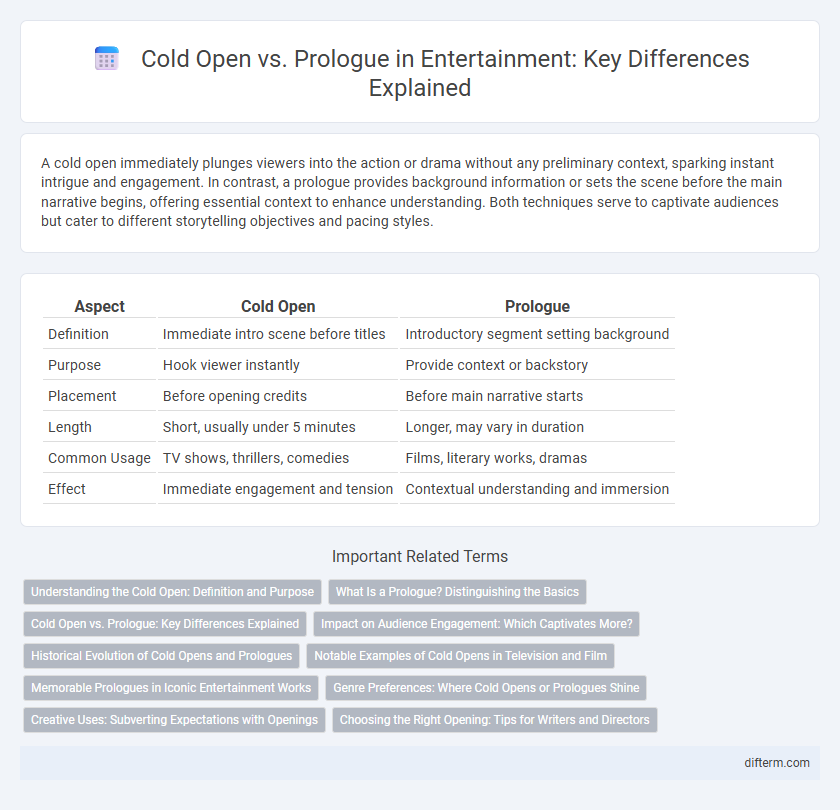A cold open immediately plunges viewers into the action or drama without any preliminary context, sparking instant intrigue and engagement. In contrast, a prologue provides background information or sets the scene before the main narrative begins, offering essential context to enhance understanding. Both techniques serve to captivate audiences but cater to different storytelling objectives and pacing styles.
Table of Comparison
| Aspect | Cold Open | Prologue |
|---|---|---|
| Definition | Immediate intro scene before titles | Introductory segment setting background |
| Purpose | Hook viewer instantly | Provide context or backstory |
| Placement | Before opening credits | Before main narrative starts |
| Length | Short, usually under 5 minutes | Longer, may vary in duration |
| Common Usage | TV shows, thrillers, comedies | Films, literary works, dramas |
| Effect | Immediate engagement and tension | Contextual understanding and immersion |
Understanding the Cold Open: Definition and Purpose
A cold open is a technique in television and film where a scene appears before the opening credits to immediately engage the audience with action or suspense. Its primary purpose is to hook viewers quickly by presenting a provocative or intriguing moment without any preliminary setup. Unlike a prologue, which often provides background or context, the cold open jumps straight into the story to boost viewer retention.
What Is a Prologue? Distinguishing the Basics
A prologue serves as an introductory section in entertainment, providing essential background information or setting the stage for the main narrative. Unlike a cold open, which starts immediately with action or dialogue to grab attention without prior context, a prologue offers exposition that enriches the audience's understanding of characters and plot. The prologue is typically positioned before the first scene or act, establishing themes and context crucial for the story's development.
Cold Open vs. Prologue: Key Differences Explained
A cold open immediately grabs viewers' attention by diving directly into a scene before the opening credits, creating suspense or intrigue without prior context. In contrast, a prologue provides background information or sets the narrative tone, often positioned at the very beginning to enhance understanding of the story. Cold opens are prevalent in TV shows to boost engagement, while prologues are commonly used in films and literary works to establish a foundation for the main plot.
Impact on Audience Engagement: Which Captivates More?
Cold opens immediately thrust viewers into the action or a gripping moment, creating instant intrigue that boosts audience engagement from the very start. Prologues provide essential background or context, enriching the story but may delay immediate connection with viewers. Therefore, cold opens generally captivate audiences more effectively by generating suspense and curiosity that encourages continued watching.
Historical Evolution of Cold Opens and Prologues
Cold opens originated in early 20th-century radio dramas to immediately capture audience attention before traditional title sequences, evolving into a staple technique in television and film for heightened suspense. Prologues trace back to classical theater, serving as contextual setup or thematic introduction to a narrative, often providing critical backstory or framing the plot. Over time, cold opens became favored for their immediacy and engagement, while prologues maintained their role in establishing narrative foundations and tone.
Notable Examples of Cold Opens in Television and Film
Cold opens have become iconic in television and film, with notable examples including "Breaking Bad," which uses gripping, suspenseful scenes to immediately hook viewers, and "The Office," where humorous antics start before the main title sequence. In cinema, "Star Wars: Episode IV - A New Hope" opens with an intense space battle that plunges viewers directly into the story world without prior exposition. These cold opens create immediate engagement and set the tone, distinguishing them from traditional prologues that provide background information before the narrative unfolds.
Memorable Prologues in Iconic Entertainment Works
Memorable prologues in iconic entertainment works establish essential backstory and tone, deeply engaging audiences from the outset. Unlike cold opens, which thrust viewers directly into action, prologues provide narrative context that enriches character motivations and plot development. Classic examples include the haunting prologue of "The Lord of the Rings: The Fellowship of the Ring" and the intense opening of "Game of Thrones," both of which create immersive worlds that elevate the storytelling experience.
Genre Preferences: Where Cold Opens or Prologues Shine
Cold opens thrive in thriller and mystery genres by immediately immersing viewers in suspenseful or action-packed scenes, creating instant intrigue. Prologues excel in fantasy and historical dramas, providing essential backstory and world-building that enrich the main narrative. Both techniques enhance storytelling but cater to different audience expectations based on genre conventions.
Creative Uses: Subverting Expectations with Openings
Cold opens grab the audience's attention by dropping them directly into action or suspense before the title sequence, creating immediate intrigue and foreshadowing key plot points. Prologues provide essential background or world-building information that enriches the main narrative, often setting a reflective or mysterious tone. Creative uses of these techniques subvert audience expectations by blending timelines or perspectives, enhancing engagement and deepening thematic impact in entertainment storytelling.
Choosing the Right Opening: Tips for Writers and Directors
Cold opens immediately immerse audiences by dropping them into action or suspense before titles, creating instant intrigue essential for thrillers and dramas. Prologues provide background information or context, ideal for complex narratives needing exposition without disrupting story flow. Writers and directors should evaluate the story's pacing and audience engagement goals to select an opening that enhances narrative impact and sets the appropriate tone.
cold open vs prologue Infographic

 difterm.com
difterm.com